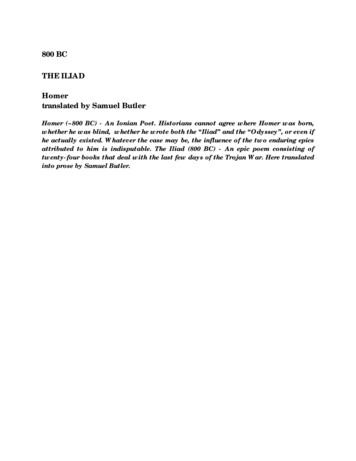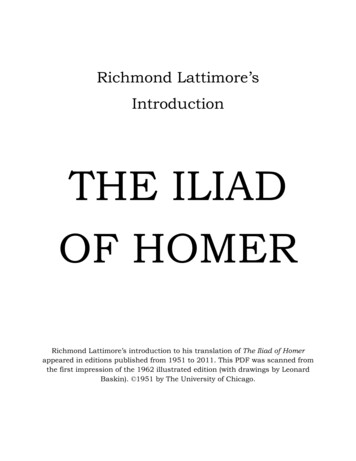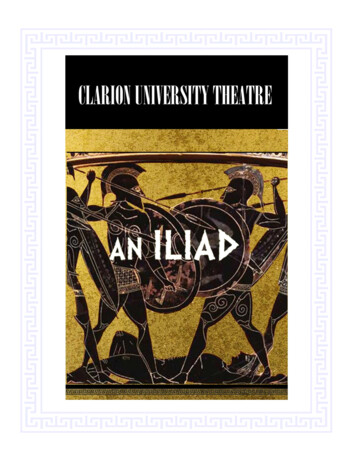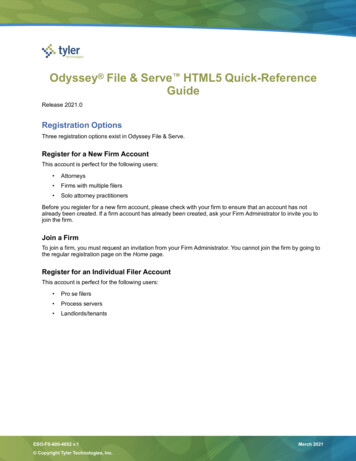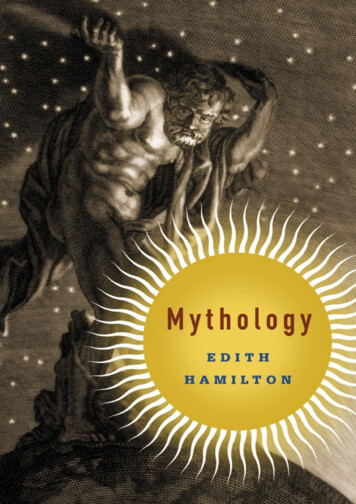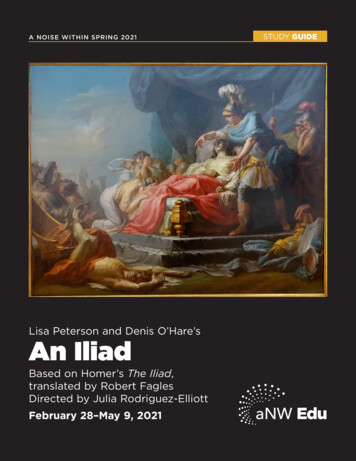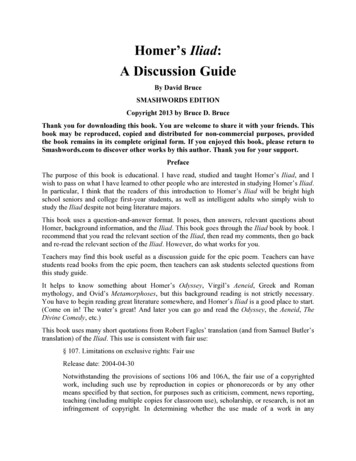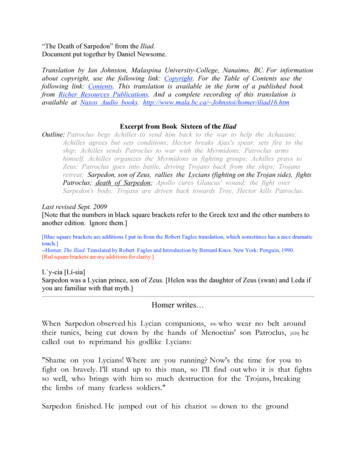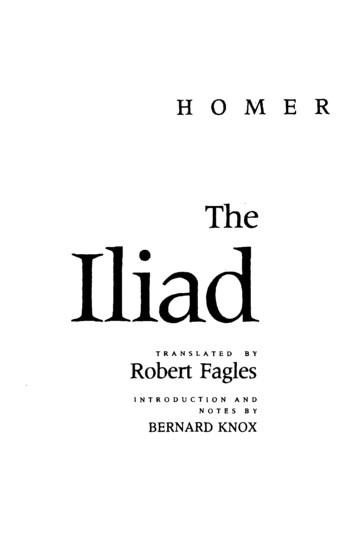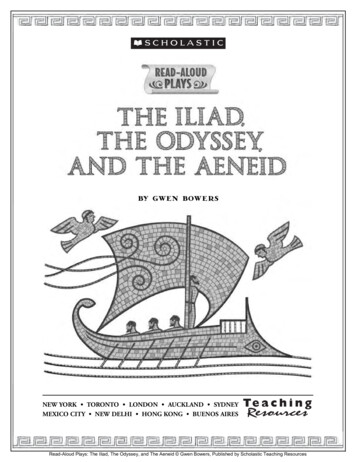
Transcription
The I liad,The Odyssey,and The Aeneidby Gwen B ow e rSNEW YORK TORONTO LONDON AUCKLAND SYDNEYMEXICO CITY NEW DELHI HONG KONG BUENOS AIRESRead-Aloud Plays: The Iliad, The Odyssey, and The Aeneid Gwen Bowers, Published by Scholastic Teaching Resources
To my dad for always expecting my best,and to the St. Charles class of 2005 for bringing these characters to life,and to Bernard and Dorothy Evslin and Ned Hoopes for breathing life intomy childhood with their inspired stories of heroes and monsters.I would like to thank Shanna Streich and Jenn Durrant for their advice, support, and friendship. I would also like to thank my editor, Sarah Longhi, and everyone who had a hand inmaking this book, for their faith and encouragement. Thanks to Lucy Hughes for help at theBritish Museum Library Reading Room. Thanks and gratitude to Professor BarbaraMacLachlan for her scholarship and classes in ancient epic. And a super-special thanks toRenato, Patrick W., Alex, Adam, Patrick D., Richard G., Peter, Mikey, and Derrick (my firstAchilles) for their unbounded enthusiasm for the ancient world!Scholastic Inc. grants teachers permission to photocopy the reproducible pages from this book for classroom use. No other part of this publication may be reproduced in whole or in part, or stored in aretrieval system, or transmitted in any form or by any means, electronic, mechanical, photocopying,recording, or otherwise, without permission of the publisher. For information regarding permission, writeto Permissions Department, Scholastic Inc., 557 Broadway, New York, NY 10012-3999.Cover design by Jason RobinsonInterior design by Melinda BelterCover Illustrations by Jeff CarinoInterior illustrations by George UlrichISBN-13 978-0439-62918-8ISBN-10 0-439-62918-7Copyright 2006 by Gwen Bowers. All rights reserved. Printed in the U.S.A.1 2 3 4 5 6 7 8 9 104013 12 11 10 09 08 07Read-Aloud Plays: The Iliad, The Odyssey, and The Aeneid Gwen Bowers, Published by Scholastic Teaching Resources
CONTENTSIntroductionIs It Possible to Teach Classical Literature toMiddle School Students? Yes! . . . . . . . . . . . . . . . . . . . . . . . . . . . . . . . 4If You Choose to Produce the Plays: Some “Don’t Sweat It” Basics . . . . . . 6Activities for Building BackgroundPronunciation Is a Key to Success . . . . . . . . . . . . . . . . . . . . . . . . . . . . . . . . . . . 8Introducing Greek and Roman Gods and Goddesses . . . . . . . . . . . . . . . . . . . 10Fascinating Facts . . . . . . . . . . . . . . . . . . . . . . . . . . . . . . . . . . . . . . . . . . . . . . . 13Activities for Extending LearningMap Adventure Through Ancient Lands . . . . . . . . . . . . . . . . . . . . . . . . . . . . . 14Using Art to Convey Meaning: Greek Vases . . . . . . . . . . . . . . . . . . . . . . . . . . 19The PlaysAn Introduction to The Iliad . . . . . . . . . . . . . . . . . . . . . . . . . . . . . . . . . . . . . . 22The Iliad (a read-aloud play) . . . . . . . . . . . . . . . . . . . . . . . . . . . . . . . . . . 25Story Summary 1 . . . . . . . . . . . . . . . . . . . . . . . . . . . . . . . . . . . . . . . . . . . 33Story Summary 2 . . . . . . . . . . . . . . . . . . . . . . . . . . . . . . . . . . . . . . . . . . . 35Themes for Reflection . . . . . . . . . . . . . . . . . . . . . . . . . . . . . . . . . . . . . . . . 37Test . . . . . . . . . . . . . . . . . . . . . . . . . . . . . . . . . . . . . . . . . . . . . . . . . . . . . . 38An Introduction to The Odyssey . . . . . . . . . . . . . . . . . . . . . . . . . . . . . . . . . . . . 39The Odyssey (a read-aloud play) . . . . . . . . . . . . . . . . . . . . . . . . . . . . . . . . 41Story Summary 1 . . . . . . . . . . . . . . . . . . . . . . . . . . . . . . . . . . . . . . . . . . . 56Story Summary 2 . . . . . . . . . . . . . . . . . . . . . . . . . . . . . . . . . . . . . . . . . . . 58Themes for Reflection . . . . . . . . . . . . . . . . . . . . . . . . . . . . . . . . . . . . . . . . 60Test . . . . . . . . . . . . . . . . . . . . . . . . . . . . . . . . . . . . . . . . . . . . . . . . . . . . . . 61An Introduction to The Aeneid . . . . . . . . . . . . . . . . . . . . . . . . . . . . . . . . . . . . 62The Aeneid (a read-aloud play) . . . . . . . . . . . . . . . . . . . . . . . . . . . . . . . . . 64Story Summary 1 . . . . . . . . . . . . . . . . . . . . . . . . . . . . . . . . . . . . . . . . . . . 74Story Summary 2 . . . . . . . . . . . . . . . . . . . . . . . . . . . . . . . . . . . . . . . . . . . 76Themes for Reflection . . . . . . . . . . . . . . . . . . . . . . . . . . . . . . . . . . . . . . . . 78Test . . . . . . . . . . . . . . . . . . . . . . . . . . . . . . . . . . . . . . . . . . . . . . . . . . . . . . 79Answer Key . . . . . . . . . . . . . . . . . . . . . . . . . . . . . . . . . . . . . . . . . . . . . . . . . . . 80Resources . . . . . . . . . . . . . . . . . . . . . . . . . . . . . . . . . . . . . . . . . . . . . . . . . . . . 81Read-Aloud Plays: The Iliad, The Odyssey, and The Aeneid Gwen Bowers, Published by Scholastic Teaching Resources
INTRODUCTIONIs It Possible to TeachClassical Literature toMiddle School Students? YES!There is no better time to address universal issueslike friendship, suffering, and betrayal than in thepreteen and teen years, and there are no better examples to use than these incredible stories—The Iliad, The Odyssey, and The Aeneid—which worktheir way into so many aspects of our culture today.Invite your class to discuss Aeneas’s position as animmigrant displaced by war, and see if students canmake the connection to current events. Let thatstudent who can’t sit still choose his favorite part toread . . . and watch him take on the role of a greathero or petulant Olympian.I have written these classics-inspired plays andactivities for my own middle school readers, whoneed highly motivating material to learn newinformation and to build reading skills. Each year,these plays captivate all types of learners—from themost challenging to the most conscientious andself-motivated. Students gain insights into the culture of ancient Greeks and Romans, and theybecome invested in the characters who drive theaction in these famous stories. At the same time, thedialogue format helps them use expression andphrasing, and repeated rehearsals build fluency andcomprehension.This resource provides you with everything youneed to teach the classic stories in an exciting andfun-filled way: 4short, engaging plays that represent theentire plot of each classic story background and history that describethe tale activities that help you teach the content andassess students’ learningAbout the PlaysHow do the three epic tales retold in these playsrelate to each other? The Iliad, a story about thebitter war between the Greeks and Trojans over thecapture of the Spartan queen Helen by Trojanprince Paris, is a prequel to The Odyssey and TheAeneid. The Odyssey tells of the Greek warriorOdysseus’s adventurous journey home after theTrojan War. The Aeneid is the story of the refugeeTrojan prince Aeneas and his long journey to finda new homeland.Studying these classics together helps studentsto better understand relationships among a family ofcharacters and deities that were at the cultural heartof the ancient Greco-Roman world. Yet, it’s alsoimportant to recognize and point out to studentsthat The Iliad and The Odyssey have a very differenthistorical and cultural context than The Aeneid.A blind Greek poet, Homer, is thought to havecommitted to memory the first two epic poems inthe mid-800s B.C. Recent linguistic research suggeststhat the rhythm and rhyme of the poems and therepetition of character epithets assisted Homer andthose who came afterward in recalling the story foraudiences. A standard text of both The Iliad andThe Odyssey was written down by scholars at theGreat Library at Alexandria in about 600 B.C.,which means the tale, having been retold manytimes over, likely changed quite a bit from Homer’soriginal telling.Read-Aloud Plays: The Iliad, The Odyssey, and The Aeneid Gwen Bowers, Published by Scholastic Teaching Resources
The Aeneid has a more certain stamp ofauthenticity. It was conceived in the form of a written document by Virgil, a well-educated writer infirst-century B.C. Rome, who counted among hisfriends some of the most famous Roman citizens ofhis time, including the Emperor Augustus. Virgilpromised the emperor he would write an epic poemthat traced Augustus’s Roman lineage back to theancient heroes and gods of the past—an epic tomatch The Iliad in stature and to establish Romanroots in the classical tradition. Though Virgil diedbefore he had completed The Aeneid, his work wasquickly published and immortalized by the Romans.How to Use This BookThis book offers a creative way for teachers of literature, history, and drama to introduce students to thebest tales from the ancient world. While a detailedtreatment of classical literature lies outside the scopeof this book, these plays and companion activities aredesigned to build essential background and improvestudents’ comprehension—and to motivate studentsto want to learn more about these ancient cultures.In the first section of the book, you’ll find a setof activities to build students’ background knowledgeand extend their learning about the classics. Following these activities are three plays—adaptations of theepics written for middle school readers—with companion activities. Each play section includes a script,stories from mythology related to the epic story, amap activity, fill-in-the-blank summaries, themes forwriting or discussion, and a test. You may want towork through the three plays and their activities inorder since the stories build upon one another, oryou may want to pick and choose materials to fityour schedule and curricular needs. At the end ofthe book you’ll find additional resources for teachingthe classics and answers to the activity pages.Here are some ways to build backgroundbefore you begin teaching with these plays: STOCK YOUR CLASS LIBRARY WITH ANYRELATED RESOURCES ON THE ANCIENT WORLD .Give students time in class to browse through thebooks. Make sure to have available a copy of each ofthe classics translated in verse or prose form so thatstudents can compare these texts to the plays theyare reading. Take the opportunity to set the stage fora scene by reading aloud a vibrant, thrilling passagefrom the unabridged text. This connects studentsmore closely to the format and style of the originalepic and helps them fill in details and become moreinvested in the story. For recommended translationsof the epics, see Resources, page 81. READ ALOUD TO YOUR CLASS EXTRA TALESWORTH THEIR WEIGHT IN TROJAN GOLD, shorttakes on classic stories associated with the charactersand events of a play. You’ll find these tales in theintroduction to each play. The letter marked next tothe story in the introduction appears beside therelated scene in the play. You might read all the talesprior to reading the play and revisit them duringyour read-through, or share each story when youand your students reach the part of the play thatbuilds on the tale. EXPLAIN TO STUDENTS THAT THEY WILLALWAYS ENCOUNTER VARIATIONS IN EACH TELLINGOF THE EPIC THEY READ .To demonstrate how variations occur in stories told in the oral tradition, suchas The Iliad and The Odyssey, whisper a sentence in astudent’s ear and have him or her pass the messagealong so that each student whispers the message inanother student’s ear. When the message has beenpassed around the classroom, ask the last studentwho heard the message to write it on the board.Write the first message on the board and marvel atthe difference between the two versions. Point outRead-Aloud Plays: The Iliad, The Odyssey, and The Aeneid Gwen Bowers, Published by Scholastic Teaching Resources5
that the Greek world had an oral tradition, and sucha tradition, by its very nature, changes constantly.You might also want to point out that variationsmay occur due to translations and adaptations, suchas the plays in this book.If You Choose to Produce the Plays:Some “Don’t Sweat It” BasicsRule 1 Don’t Be Afraid!Rule 2 Just Do It!Rule 3 Enjoy!Plays are exciting and motivational for students—and the repetition of lines and expression of the dialogue reinforces students’ understanding of the classicstories in this collection. If you want to produce aplay, let students do most of the production workwhile you offer some basic guidance. Here are sometips for engaging students in a successful production: After several read-throughs, provide time for students to generate ideas for backdrops and props.(They’ll come up with inventive solutions wegrown-ups would never dream of.) To make the most of class time, avoid lengthy andnerve-wracking auditions; assign parts for theplays. Have students choose their five favoriteparts and list them in order of preference on ascrap of paper. Collect the choices and write students’ names in a grid under their choice numberfor the part (see example, page 7). Circle the nameof the student you choose and then cross out allthe rest of the names in that row. To avoid assigning two parts to one student, when you chooseyour student, cross out that student’s name underhis or her four other choices. Statistically, thismethod assures that nearly everyone gets some6thing they ask for. If students are lucky enough tohave you for several years, you can remind themthat there will be another chance next year. To announce the parts, print out a class list andwrite their parts next to their names. Tell students that the parts will be posted in the hallwayat the end of the school day. Watch as the suspense builds all day long. By posting the list, youavoid discussing your decisions, and as a bonus,have a ready reference when the kids want towrite a program for the performance. On thebottom of the class list write “Highlight yourparts and start learning your lines!” To involve all of your students in the play, add asmany characters to the scene as possible, evenones who have no speaking parts. (Keep in mindthat the student who doesn’t want a speaking partmay still want to participate.) Group scenesencourage full participation; plan to have all students onstage for weddings, battle scenes, andcelebrations. You may also want to establish“anchor” characters who stay onstage for the duration of the play, as well. For example, Penelopemay be onstage at her loom weaving and waitingthroughout the performance of The Odyssey.Similarly, archrivals Hera and Venus may be seated on embellished thrones on opposite sides ofthe stage throughout a production of The Aeneid. Do a class read-through acouple of times beforeA pronunciationallowing students to get onactivity and keytheir feet to work out theis providedon pages 8–9.scenes. Remind students tospeak slowly, loudly, andclearly. After students are comfortable speakingtheir lines, have them concentrate on addinginteresting movements and gestures.Read-Aloud Plays: The Iliad, The Odyssey, and The Aeneid Gwen Bowers, Published by Scholastic Teaching Resources
ASSIGNING PARTSWhen assigning parts, always be mindful ndMichaeldents. For example, take a look at my decisions for assigning roles to five students,Michael, Daniel, Jack, Ryan, and Bram. I’velisted the top five choices of each studenthave their hearts set on playing the part ofDavidJackbrave Achilles. I have chosen Bram over theMichaelothers because Bram is a bit shy, and I feelthat this important role might help himDanielMenelauscome out of his shell. I’ve circled Bram’sRyanBramDaniel5thon a grid (left). Michael, Bram, and Ryan the social and academic needs of your stu-crossed out his four other choices. My decision to give Jack his first choice, as well, isBramMichaelbased on Jack’s professed love of poetry andhis assertion that he identifies strongly withDanielRyanAjaxPatroclusPriamApollo. Michael, on the other hand, will beDanielRyanBramMichaelHectorname for his first choice, Achilles, andJack Lead students in a full rehearsal. Remindstudents of these pointers:—Enunciate and add expression as you speakyour lines.—Move through the play as you read it; “block”it out, marking each line in your script toshow the place you should be onstage.—Come up with gestures that add interest toyour presentation.The PerformancePublicize the performance. Contact your local newspaper and let them know about it. You are morethan likely to get someone to come out, as journalists are always looking for local stories of interest.BramJackassigned his fifth choice, the role of Zeus,because he has the starring role in a dramaproduction presented in a few weeks by hisdrama teacher. That decision will allow morestudents to receive their top choices.Have the kids make flyers, invitations, and posters.You might also consider hiring a professionalvideographer to videotape the performance and thenhave copies made for students. Or you might use adigital camera and upload the performance to theschool’s website. This way, parents who work duringthe school day can see it. And if your schoolhas a yearbook or newspaper, be sure to let theappropriate committee know in advance so thatphotos can be taken and interviews can be conducted. To help spread the word, put up a bulletinboard of Greek vases (see pages 19–21) outside yourclassroom—or better yet, reserve the main bulletinboard near the front office—and label it “FamousScenes from Ancient Stories.”Read-Aloud Plays: The Iliad, The Odyssey, and The Aeneid Gwen Bowers, Published by Scholastic Teaching Resources7
Activities for Building BackgroundPRONUNCIATION IS AKEY TO SUCCESSIf students have had little exposure to Greekpronunciations, they may find their attemptsto pronounce the characters’ names in theseplays frustrating and distracting. This is asure trigger for getting the class off-track.Knowing how to pronounce words properlyhelps students build confidence and focuson the story line.MaterialsPronunciation Key (page 9)BASIC BACKGROUND ON THELANGUAGE TO SHARE WITH STUDENTSThe Iliad and The Odyssey were oral traditions, and when theywere finally written down, they were composed in an early form ofthe Greek language. The Aeneid was written in Latin. Though bothancient Greek and Latin are now considered “dead” languages (theyare no longer used in common spoken and written language), all ofthe epics were translated into more current forms of Greek and Latinover many centuries. Scholars are still writing new translations inmany languages to this day.Because there have been so many translations over so manyWhat to Docenturies, students will come across names of characters and places1. Distribute copies of the Pronunciation Keyin one of three forms: the Greek transliteration (from the original),to students or enlarge the key and hang itin a visible spot in the classroom.2. Share with students some backgroundabout the language used in the plays (seeBasic Background, right).3. Write all character names on the boardbefore the first read-through of a play.4. Model the pronunciation of each charactername, referring to the Pronunciation Key.5. Have students repeat after you severaltimes (in order, faster, at random, and soon). Address any area of difficulty andencourage students to assist each otherwith the pronunciations.6. Conduct a read-through of the play,stopping after Scene 3 to review thenames of characters.the Latin form (from an early translation), or Latinate form (from latertranslations). Why not return to the original Greek? Because so manycharacter and place names are familiar and widely accepted in theirLatin or Latinate forms. Look at Achilles and Helen as examples.Akhilleus is transliterated from the Greek, while Achilles is the Latinand familiar form we use today. Helene is transliterated from theGreek, Helenae is the Latin form, and Helen is the Latinate andfamiliar form we use today. Because of the evolution of thesenames, inconsistencies abound, and as a rule, you and your studentswill find Greek forms beside Latin and Latinate versions within thesame text.Spellings of ancient Greek names vary. In the three plays thatfollow, you’ll find a c instead of k in names such as Calypso, which isless frequently spelled Kalypso. Ask students about variationson modern names and share examples such as Rachel/Rachael,Jon/John, and so forth. Point out that many scholars of classicalliterature disagree about which forms to use, so students may findvariations in spellings among the different versions of the classicsthey read. Explain that in these plays no standard system of transliteration has been used, but Greek and Roman names are given in theway that’s most familiar to readers of English.8Read-Aloud Plays: The Iliad, The Odyssey, and The Aeneid Gwen Bowers, Published by Scholastic Teaching Resources
Pronunciation KeyHere are some general rules for pronouncing Greek and Latin words from The Iliad,The Odyssey, and The Aeneid.LETTER/LETTER COMBINATIONBUILDBACKGROUNDSOUNDEXAMPLEcheusaus / ouskyoosay-oos / o-oos(each initial vowel is distinct)Chiron (KEYE ron)Odysseus (uh-DIS-yoos)Menelaus (me ne LAY oos)Arsinous (ar SI no oos)c/gk/g(hard before a, o, u,and all consonants)Agamemnon (a ga MEM non)Clytemnestra (kleye tem NES tra)c/gs / j (soft, before e, i, and y)Mycenae (mi SEE nee)cia / giasha / jaLycia (LI-sha)Phrygia (FRI-ja)caeseeCaesar (SEE-zar)e (final)eeLaodice (lay O di see)eseezOrestes (o RES teez)u (represents the Greek diphthongou, so is always long)oo or uh and sometimes you(except in combination withother vowels and in ou / us)Telemachus (te LE ma koos)Troilus (TROY luhs)Muse (MYOUS)oe / aeeePhoebus (FEE boos)Achaeans (AKEE unz)eiee-iBriseis (bri SEE is)ooohoLaocoon (lay awk oh ON)äeay-ee(the two dots, called direses,are used to show that eachletter is sounded separately)danäe (DA nay ee)xks or zPolyxena (po LIKS ee na)ORPolyxena (po LIZ ee na)Read-Aloud Plays: The Iliad, The Odyssey, and The Aeneid Gwen Bowers, Published by Scholastic Teaching Resources9
INTRODUCING GREEK ANDROMAN GODS AND GODDESSESLearning the names and roles of the gods and goddesses is essential to understanding these plays—the moody temperaments of the Olympians steer thecourse of events in each of the classics. A bitter feudamong three jealous goddesses catapults the Greeksand Trojans into war in The Iliad and then drivesDido to suicide, creating bad blood between Romeand Carthage in The Aeneid. It isn’t wind patternsthat delay Odysseus’s homecoming for nearly adecade—it’s the vicious bickering of the Olympians.In these classic tales, mortals are mere playthings ofthe Greek deities and subject to their every whim.MaterialsGreek Gods and Goddesses and Their RomanEquivalents (page 11), Greek and Roman Gods andGoddesses Test (page 12), pensHere’s How1. Distribute copies of Greek Gods and Goddessesand their Roman Equivalents to students.2. Have students discuss what they already knowabout the names of gods and goddesses they findlisted. Ask them where they may have seen thesenames before. Answers may include places such asthe Apollo Theatre, newspaper names such as TheSan Jose Mercury News, movie titles such as ThePoseidon Adventure, and the names of the planets(Mars, Saturn, Mercury, Venus, and Jupiter). Theymight also offer names of sports teams, bands, andsong titles. Ask them what words we use regularlythat might have their roots in these names. Theymay offer chronology (from Kronos, the god of time)or cereal (from Ceres, the goddess of grain). You canalso have them search for examples of businesses10that use the names of gods and goddesses from thebusiness section of the telephone directory.3. Discuss the 12 Olympians and their relationshipswith one another and with mortals. Make surestudents are familiar with these key relationships:Kronos and Rhea, immortal beings calledTitans, are two children of Uranus (father sky)and Gaea (mother earth). Kronos and Rheahave a number of children, called Olympians.Among them are Hestia, Demeter, Hera,Hades, Poseidon, and Zeus. Zeus and Hera, besides being brother and sister,are also king and queen of the Olympians. Theirchildren include Hebe, Ares, and Hephaestus.Both have children with other divinities andwith mortals, as well. Zeus’s children include theimmortals Athena, the twins Artemis andApollo, Dionysus, Hermes, and Heracles. Important mortal characters in the epics aresometimes said to have an Olympian as a parentor protector. This is true of Helen, Clytemnestra,Achilles, and Aeneas. According to some legends,Zeus and Leda, a mortal, are the parents ofHelen of Troy and her sister Clytemnestra. Heraprotects and raises Thetis, Achilles’ mother.Aeneas is born to Aphrodite (Venus) and theTrojan Anchises, whom Aeneas carries on hisshoulders from the burning city of Troy andeventually buries on the island of Sicily. 4. When students have had ample time to learnsome basic relationships, assign the test date.5. Hand out copies of Greek and Roman Gods andGoddesses Test, and assess students on the knowledge they’ve gained.Read-Aloud Plays: The Iliad, The Odyssey, and The Aeneid Gwen Bowers, Published by Scholastic Teaching Resources
Greek Gods and Goddessesand Their Roman EquivalentsBUILDBACKGROUNDDuring the Golden Age of Ancient Greece (approximately 500 to 300 B.C.), literature and artflourished, and ideas about philosophy, government, and justice were conceived and debated.Many Roman emperors, like Augustus (approximately 63 B.C. to 14 A.D.) sought to link theirculture and historical roots to the esteemed ancient Greeks.One of the most notable influences of ancient Greek culture in theRoman Empire was on religious beliefs. The Romans worshiped the sameThe twelvegods and goddesses as the Greeks, but changed their names and sometimesOlympians areemphasized different aspects of their dispositions. For example, the Greekgod of war, Ares, was portrayed as a vicious, blood-thirsty tyrant, while theshown in bold print.Roman god of war, Mars, was seen as the epitome of strength and victory—a reflection of the warlike mindset of this expanding empire.Greek NameApollo. . . . . . . . . . . . . . . . ApolloAphroditeAresRoman NameArtemis . . . . . . . . . . . . . . . . Diana. . . . . . . . . . . . . goddess of love and beauty . . . . . . . . . . . . . dove, rose, seashell. . . . . . . . . . . . . . god of war . . . . . . . . . . . . . . . . . . . . . . . . . . . spear, torch, vulture, dog. . . . . . . . . . . . . . goddess of the moon and the hunt . . . . . . . the moon, deer. . . . . . . . . . . . goddess of wisdom and strategy in war . . . owl, oliveAthena . . . . . . . . . . . . . . . . MinervaDemeter. . . . . . . . . . . . . . CeresSymbol/s. . . . . . . . . . . . . god of the sun, music, and poetry . . . . . . . . sun, lyre, laurel. . . . . . . . . . . . . Venus. . . . . . . . . . . . . . . . . . MarsRole. . . . . . . . . . . . . . goddess of the harvest . . . . . . . . . . . . . . . . . poppy, wheat, and grainDionysus . . . . . . . . . . . . . . Bacchus . . . . . . . . . . . . god of wine . . . . . . . . . . . . . . . . . . . . . . . . . . grapes, goatEros . . . . . . . . . . . . . . . . . . . Cupid. . . . . . . . . . . . . . god of love . . . . . . . . . . . . . . . . . . . . . . . . . . . bow and arrowHades. . . . . . . . . . . . . . king of the underworld . . . . . . . . . . . . . . . . . scepter, two-pronged staffHebe. . . . . . . . . . . . . . . . Pluto. . . . . . . . . . . . . . . . . Juventas. . . . . . . . . . . . goddess of youth . . . . . . . . . . . . . . . . . . . . . . pitcher of water. . . . . . . . . . . . . god of fire and metal . . . . . . . . . . . . . . . . . . . fire, hammer, anvilHephaestus . . . . . . . . . . . . VulcanHera . . . . . . . . . . . . . . . . . . Juno . . . . . . . . . . . . . . . queen of the gods . . . . . . . . . . . . . . . . . . . . . peacockHeracles . . . . . . . . . . . . . . . Hercules . . . . . . . . . . . . god of strength . . . . . . . . . . . . . . . . . . . . . . . club, lionskinHermes . . . . . . . . . . . . . . . Mercury. . . . . . . . . . . . messenger of the gods . . . . . . . . . . . . . . . . . caduceus, winged sandals, andhelmetHestia. . . . . . . . . . . . . Vesta. . . . . . . . . . . goddess of the hearth and home . . . . hearthKronos. . . . . . . . . . . . . . . . Saturn. . . . . . . . . . . . . god of time . . . . . . . . . . . . . . . . . . . . . . . . . . sundialPersephone . . . . . . . . . ProserpinaPoseidon . . . . . . . . . . . . . . NeptuneZeus . . . . . . . . . . . . . . . . . . Jupiter. . . . . . . queen of the underworld . . . . . . . . . . pomegranate. . . . . . . . . . . king of the sea . . . . . . . . . . . . . . . . . . . . . . . . trident. . . . . . . . . . . . . king of the gods . . . . . . . . . . . . . . . . . . . . . . . thunderboltActivity: Draw lines dividing the back of this page into four quadrants. Draw a symbol in each:a trident, a lyre, a caduceus, and an anvil. Then, underneath each symbol, write the name of the god orgoddess the symbol represents.Read-Aloud Plays: The Iliad, The Odyssey, and The Aeneid Gwen Bowers, Published by Scholastic Teaching Resources11
Name DateGreek and Roman Gods and GoddessesMatch the god or goddess to his or her role.1. Kronos/SaturnA. goddess of the hearth and home2. Zeus/JupiterB. god of the sun, music, and poetry3. Dionysus/BacchusC. god of speed; messenger of the gods4. Hera/JunoD. god of wine5. Hebe/JuventasE. god of fire and metal6. Hades/PlutoF. king of the sea7. Hephaestus/VulcanG. the home of the gods and goddesses8. Persephone/ProserpinaH. goddess of the moon and hunting9. Ares/MarsI. goddess of the harvest10. Poseidon/NeptuneJ. god of love11. Artemis/DianaK. god of time12. Demeter/CeresL. king of the underworld13. Athena/MinervaM. goddess of love and beauty14.
making this book, for their faith and encouragement. Thanks to Lucy Hughes for help at the British Museum Library Reading Room. Thanks and gratitude to Professor Barbara MacLachlan for her scholarship and classes in ancient epic. And a super-special thanks to Renato, Patrick W., Alex, Adam,

